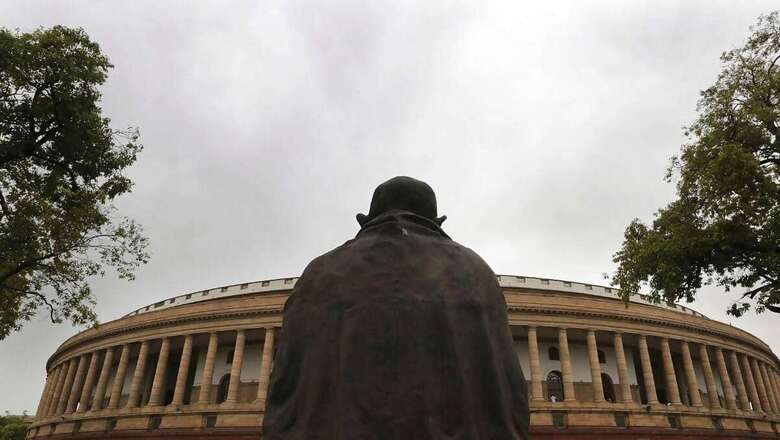
views
Yogendra Yadav recently highlighted the crisis of political thinkers and political imagination. In response, Peter DeSouza, Salmoli Choudhuri, Moiz Tundawala, and Hilal Ahmed have provided vivid and substantive insights. These responses have reignited the debate on the current state of political imagination, addressing issues ranging from its absence to its presence in mundane places and actions.
Political imagination is essential for any political community. Several intriguing questions arise: Who engages in political imagination? What does this imagination entail, and what crises are we referring to? Is it a crisis of imagination for certain classes trained in English and writing for newspapers, journals, or books? Are we limiting imagination to universities or party intellectuals? Can those outside these two realms think and contribute to political imagination in a Gramscian sense? Is it possible to blend multiple ideas, or does the repetition of a single idea constitute imagination? Where is the rupture, and what does it signify? Can imagination emerge after a rupture? And, who is willing to take the risk of rupture to foster new imagination?
It is not feasible to address all these questions here. However, three key issues can be explored under the concept of the ‘risk of imagination,’ which touches on these concerns both directly and indirectly: rupture, irrelevancy, and political imagination. Collectively, these can be seen as constituting the risk of imagination.
In its true spirit, rupture goes beyond merely blending ideas into a new form. It cannot be uncritical or purely derivative; instead, it jolts us, shaking us out of epistemic and academic conformity. It politely disagrees yet radically proposes. Rupture transcends the typical debates of past versus future, or continuity versus discontinuity. The essential point is how we respond to crises in a new, innovative way. While many may address the same crises without rupture, the rupture itself represents a substantive departure from mainstream debates.
It examines crises through a fresh lens, offering alternative forms of action. This discomfort is not only intellectual—stemming from epistemic disagreement—but also urges discomfort in the form of political action. The combination of intellectual discomfort and political action makes rupture particularly relevant for political organisations.
Rupture also invites the risk of irrelevancy from peer groups and organised and unorganised institutions. Rupture and the risk of irrelevancy are, indeed, intertwined. The idea of rupture cannot originate from the location of conformation; confirmation inherently resists rupture. Since confirmation is a requirement for non-rupture, the risk of irrelevancy becomes moot. The idea of irrelevancy, therefore, takes cognisance not only of the irrelevance of theorists epistemically, but also in the form of everydayness and the question of survival itself.
A slew of works is not deliberately considered in the epistemic sphere. Questions of caste, class, gender, race, and minorities (sexual, religious, linguistics) may remain unrecognised or unnoticed, or be reduced to irrelevancy, in the case of ‘rupturing’ the discourse. In the sphere of organised and unorganised institutions, non-epistemic obstructions, like access to jobs and services, become the main impacting areas.
The process of rupture becomes crucial for the debate on new imagination. The rupture is either followed by progressing imagination or dystopian imagination. The risk of theorising rupture is the line of intellectuals alone, and there may be short-term irrelevancy from peers. Are intellectuals ready for short or long-term irrelevancy? The theorisation of rupture must be considered with irrelevancy. This can then offer the path of imagination.
Rupture and the risk of irrelevancy lead to an expressive self, unrestrained by social, economic, and political protocols. Does irrelevancy always occur? It may not. Should the author or theorists/non-theorists be prepared for irrelevancy? Yes, they should. Democratic societies mitigate an author’s irrelevancy by engaging epistemologically with the necessary wherewithal. Political imagination proposes the statecraft for new societies. However good the existing model may be, it cannot remain unchangeable or unalterable.
Political thinkers challenge the fallacy of the unchangeable or the retreat to it. This fallacy breeds diffidence, not confidence. There are two correlational concerns: what happens to the author when structures uphold the fallacy of the unchangeable? Would the author be immune to this subsumption? The answer is that authors are those who resist the retreat to the unchangeable, despite the control of structures. The moot question is how to recognise new political imagination.
If there is a focus on the structures and their paraphernalia, it may not give the idea of new imagination or new political thinkers. There is no suggestion that sites of structure should not be taken seriously. The seriousness should not hinder the imagination available outside the domain of the structure. Is it possible to have autonomy outside the structure? Perhaps yes. This could be voluntary or coercive. A voluntary option is rarely available. There may be coercive exclusion. The new imagination and authors of new political vocabulary can be located herein.
One notable example in this regard is Gandhi’s catalyst speech at the occasion of the inauguration of Benares Hindu University in February 1916, which serves as an important signifier. This speech marked a rupture in communication and language, displaying remarkable courage in standing against a political class influenced by the colonial empire, landlords, and zamindars.
On the invitation of Madan Mohan Malviya, Gandhi delivered his highly anticipated speech on 4 February 1916, during the opening of Benares Hindu University—an event of great significance for all present. Lord Hardinge, the Governor-General of India, was laying the foundation stone, and security was unprecedented. The Maharaja of Darbhanga presided over the session. In the midst of the highly lauded speeches, Gandhi said, “It is not enough that our ears are feasted, that our eyes are feasted, but it is necessary that our hearts have got to be touched and that our hands and feet have got to be moved.”
He further expressed his discontent with the language used for the gathering, stating, “I wanted to say it is a matter of deep humiliation and shame for us that I am compelled this evening, under the shadow of this great college, in this sacred city, to address my countrymen in a foreign language.” Gandhi highlighted the need to work for the poor and make research accessible to the masses, stressing that practical conduct and substantive speeches were essential for achieving self-government.
Gandhi wanted to “think audibly.” In the context of temples, he questioned the state of cleanliness in Benares. Addressing the opulence of the Maharajas seated on the dais and in the gathering, he declared, “There is no salvation for India unless you strip yourselves of this jewellery and hold it in trust for your countrymen in India.” He linked the grandeur of the city’s landmarks to the wealth of agriculturalists, stating, “Sir, whenever I hear of a great palace rising in any great city of India, whether in British India or in the India ruled by our great chiefs, I become jealous at once and say, ‘Oh, it is the money that has come from the agriculturists.’”
Gandhi then invoked God, critiquing the heavy security surrounding the Viceroy: “All of us had many anxious moments as the Viceroy moved through the streets of Banaras. There were detectives stationed in many places. We were horrified. If we trust and fear God, we shall fear no one—not the Maharajas, the Viceroys, the detectives, or even King George.” The underlying message was one of ethical conduct and equal treatment for all. Gandhi rejected violence and advocated non-violence as a core principle. During his speech, Annie Besant urged him to stop, yet his speech remained inclusive, despite many leaving the venue (Speech at Benares Hindu University, 6 February 1916, The Collected Works of Mahatma Gandhi, vol. XIII, pp. 210-216, 1964).
Later, the Maharaja of Darbhanga urged the princes present to disapprove of Gandhi’s remarks, which they received with “grief and pain.” The response was unanimous: “We all disapprove” (Extract from a letter to the Maharaja of Darbhanga, 7 February 1916, The Collected Works of Mahatma Gandhi, vol. XIII, pp. 216-217, 1964).
Later, Gandhi remarked that after noticing “a stir on the platform and that Mrs Besant was whispering to the Princes who were sitting near her, I neither withdrew nor explained. I observed the Princes rising one after another, and as the Chairman also left, I could not finish my speech.” However, Besant refuted this claim, stating, “I did not suggest to the Princes to leave” (Interview to A.P.I. on Benares ‘Incident’, 9 February 1916, The Collected Works of Mahatma Gandhi, vol. XIII, pp. 217-218, 1964).
This speech was delivered by Gandhi, a year after his successful Satyagraha in South Africa. His rupture was against the opulence, surveillance, sycophancy, and glitter of the Princes and Zamindars, the use of an alien language, and the exploitation of farmers under British rule. Gandhi was, at that moment, almost irrelevant to both the colonial masters and those who opposed them. This marked the assertion of his concept of Swaraj, showcasing a new political imagination. He countered the risk of irrelevancy imposed by both the empire and its opposition by resonating with the masses through his message. The rupture became a hypothesis, and the risk of irrelevancy transformed into Satyagraha.
This debate is compelling as it provokes thought on the decline of political thinkers and political imagination. It serves as a critical reminder of the precarious state of imagination today. However, it is also worth noting that many are attempting to rupture from conventional norms by becoming irrelevant to their peer groups and institutions. This is not to suggest that rupture can be achieved solely through irrelevancy. Rather, the meaning of political imagination can be interpreted differently at the sites of both rupture and irrelevancy. Movements also provide spaces for rupture, the risk of irrelevancy, and imagination. Those involved in such movements are, themselves, political thinkers.
Dhananjay Rai teaches at the Centre for Gandhian Studies, Central University of Gujarat. Views expressed in the above piece are personal and solely those of the author. They do not necessarily reflect News18’s views.




















Comments
0 comment